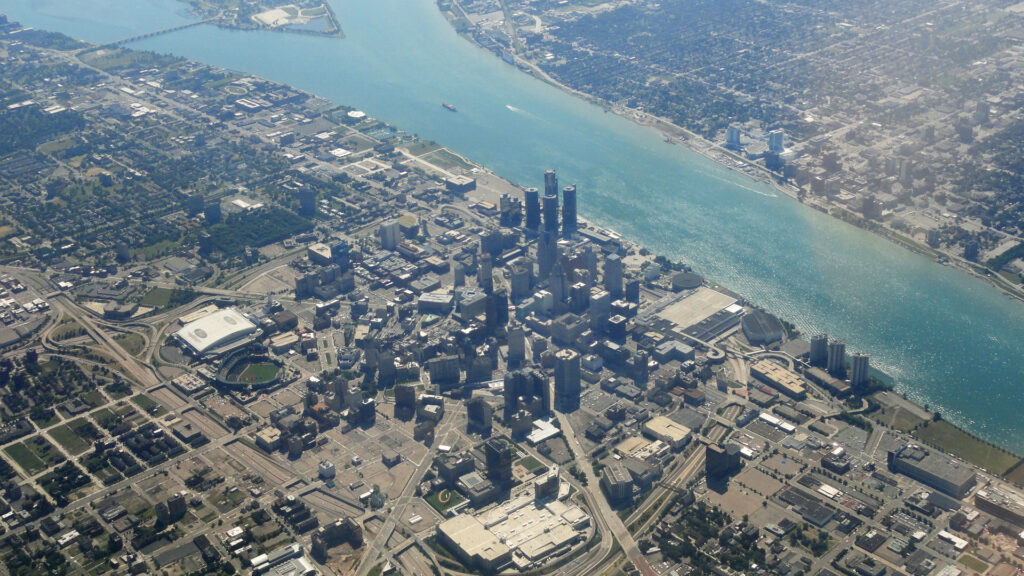
Baseline Health Impact Assessment for the Gordie Howe International Bridge Project
Summary
The Southwest Detroit Community Benefits Coalition (SW Detroit CBC) formed in 2008 in response to plans for a new international bridge in southwest Detroit—an area already burdened by heavy industry and pollution. Representing hundreds of residents and community stakeholders, SW Detroit CBC has worked for over a decade to secure benefits that improve quality of life for those most impacted by the Gordie Howe International Bridge (GHIB).
While federal studies predict improved regional air quality, residents remain concerned about local pollution from increased traffic and industrial activity. In 2017, $45 million in community benefits was approved to support job training, health and air quality monitoring, home repair and relocation programs, and other initiatives to reduce neighborhood impacts.
The Baseline Health Impact Assessment (HIA)—a collaboration between SW Detroit CBC, the Detroit Hispanic Development Corporation, the University of Michigan, and the Detroit Health Department—documents current air quality and health conditions in the bridge area. Data collected between 2016–2018 provides a foundation for tracking future changes and identifying strategies to protect residents’ health as bridge operations begin.
Three Phases of GHIB Health Impact Assessment
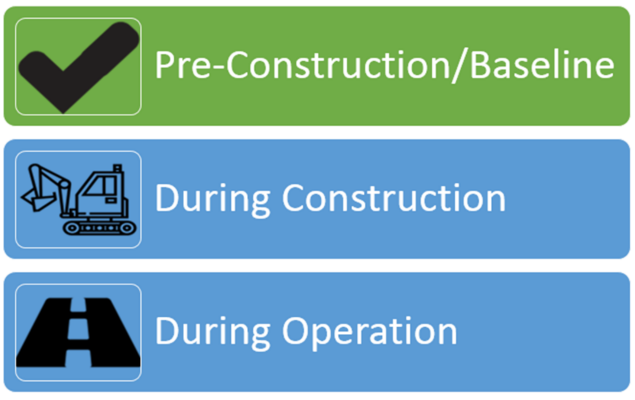
Results
The BHC and GHIB surveys asked questions about current health status, and resident concerns, and invited for input on potential strategies to reduce air pollution emissions and exposures. The full report includes data from closed and open-ended questions and secondary sources, along with a full description of the survey methodology and protocols.
In the BHC 2016-2017 survey, 302 households were surveyed. Respondents included residents throughout Delray and within 500 feet (about 1 1/2 blocks) adjacent to the North Service Drive of I-75.
In the 2018 GHIB survey, 146 households were surveyed. Of those, 26 households from the 2016-2017 survey were re-interviewed as a replicate sample. Respondents to the 2018 survey were primarily residents living between 500 to 1500 feet (about 1 1/2 to 5 blocks) north of the North Service Drive of I-75.

Survey sections included:
- Demographics (age, education or survey respondents, etc.)
- Resident’s Self-reports on their neghborhoods, social support, and concerns
- Housing characteristics
- Health status of household members
- Resident’s suggestions for how to address concerns
Results reported in the Baseline HIA Report include data for 435 adult respondents, and information reported by survey respondents for about 1,629 household members of all ages.
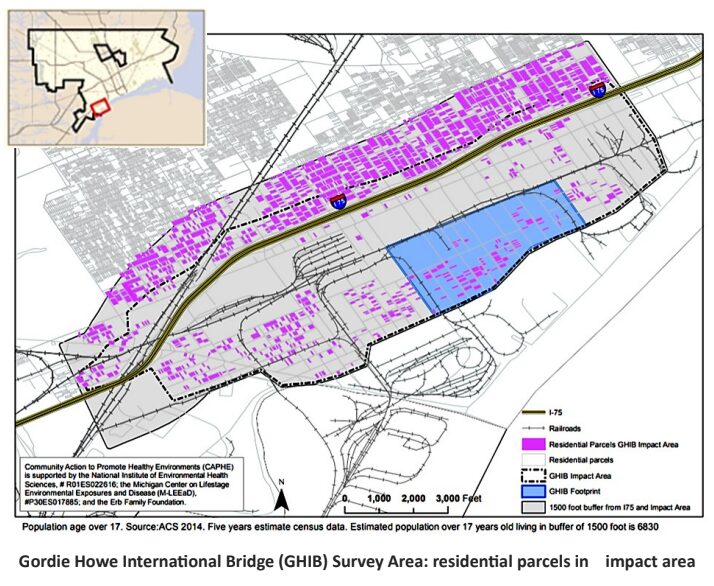
Neighborhood and Social Support
Emotional, tangible and informational social support are linked to better health outcomes.
Neighbors can be an important source of social support. The survey asked residents how they
felt about their neighborhoods, and about their social relationships with their neighbors.
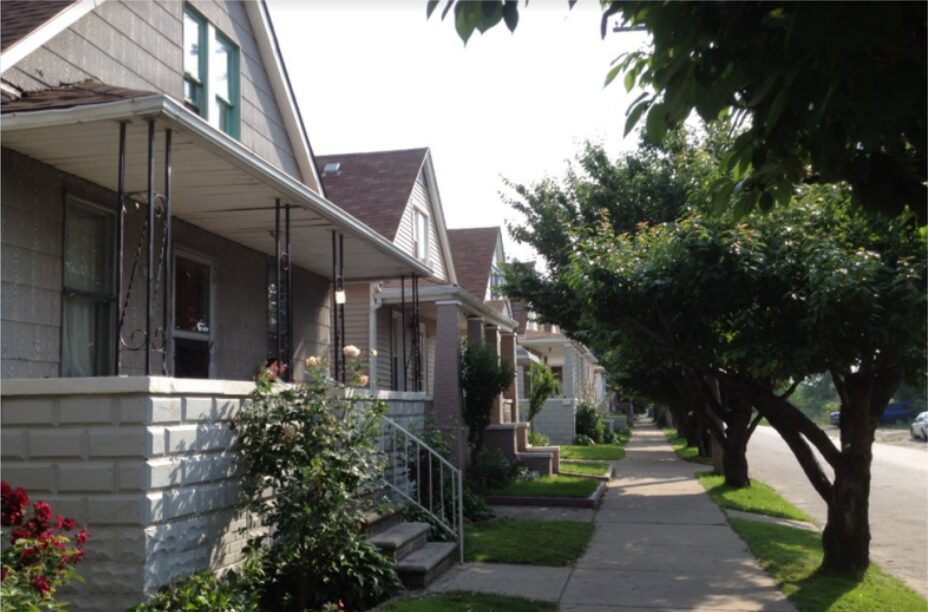
86% felt at home in their neighborhood
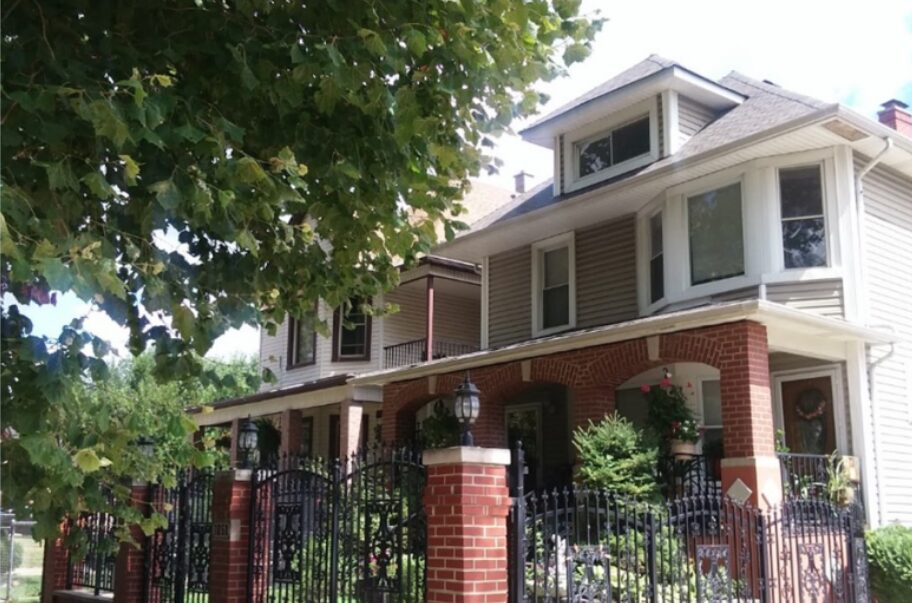
70% felt their neighborhood was a good place to live
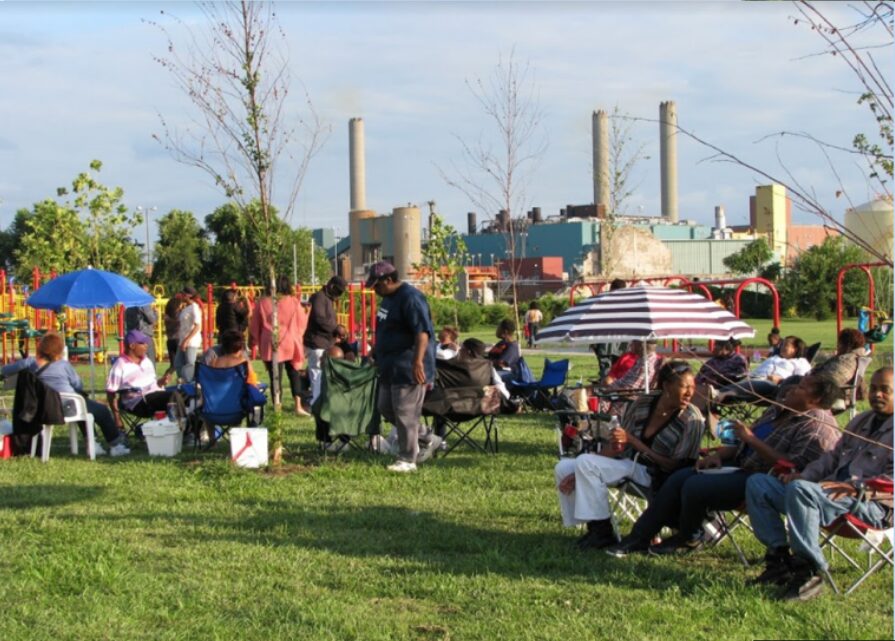
73% had others they could turn to if they needed help around the house
Plans To Move & Neighborhood Concerns
At the time of the survey, a majority of residents reported they did not plan to move. In the GHIB impact area, 26% of respondents indicated they planned to move in the next 5 years or less, compared to 16% of respondents living north of I-75. Implementing strategies to protect the residents that remain from exposure to air pollutants could reduce adverse effects of air pollutants on their health.
The BHC and GHIB baseline surveys were conducted prior to bridge construction. Construction phase impacts, as well as operational phase impacts of the GHIB on residents lives may influence resident’s plans to move over time.
Survey respondents reported concerns about air pollution and noise associated with the bridge in the BHC and GHIB baseline surveys.
65-67% Indicated that outdoor air quality was a top concern, including emissions from trucks or industry, fumes, and odors
46-47% Indicated that noise was a top concern

In the GHIB survey, the proportion of respondents indicating that the following were “very much a concern” were:
| 76% | Traffic congestion making it hard to get places |
| 75% | Clogged sewers or standing water in the streets |
| 61% | Vibration from trucks or construction activity damaging property |
| 60% | Road dust |
| 57% | Loss of property value |
Health Status Of Household Members
Percent of household members in the baseline HIA survey reported to have asthma by age and distance from I-75 and trucking routes
Survey respondents were asked to report on their own health and that of other members of their households. The n = is the total number of people about whom health was reported.
The prevalence of reported asthma among children under the age of 18 in the GHIB area was 13.8%. Among those living 500 feet or less from I-75 or trucking routes through the GHIB area, the prevalence was 16.3%. Prevalence of reported asthma for those aged 65 and older living 500 feet or less from I-75 or trucking routes was 24.4%, compared to 12.9% for those in this age group living more than 500 feet from those roadways.
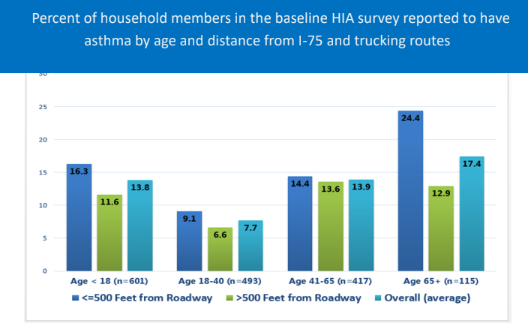

The Michigan Behavioral Risk Factor Survey indicates that 14.3% of children under the age of 18 in Detroit have been told by a health care provider that they currently have asthma, compared to 8.9% of children under 18 in Michigan.
Health conditions reported for children under the age of 5
Frequent Health Issues
Of the 148 children under the age of 5 on whom data was obtained, 10.8% were reported to have allergies affecting breathing, followed by asthma (7.4%), skin problems (6.8%), and other lung/respiratory conditions (6.1%). Between 4-5% of children under 5 were reported to have frequent illnesses, coughing, other health issues not included in the pre-identified list, and developmental/learning issues.
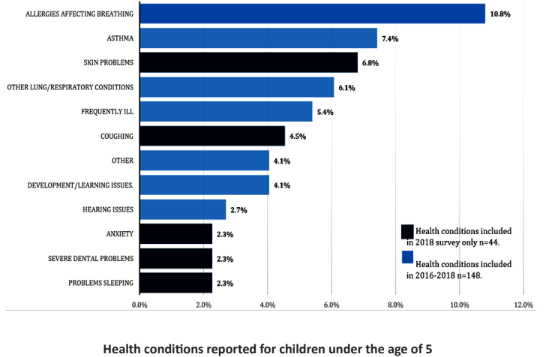
Health conditions reported for those aged 5-17
Frequent Health Issues
In this age group, nearly 1 in 5 children were reported to have allergies affecting breathing (19.2%). The second most commonly reported health issue was asthma (15.9%). Frequent eye irritation or infections or other eye problems were reported for 13.3%. Between 8 and 9% reported frequent headaches, skin problems, developmental or learning issues, coughing or problems sleeping. 7.3% reported anxiety, 6% reported frequent illnesses, and between 2-3% in this age group reported hearing issues, autism, depression, other lung/respiratory
conditions and severe dental problems.

Health conditions reported for those aged 18-40
Frequent Health Issues
About 1 in 5 in this age group report frequent headaches (21.5%) and allergies
affecting breathing (19.1%). Frequent eye irritations or infections or other eye problems were reported by 18.5%, 14.7% reported anxiety, 13.6% problems sleeping, and 12% reported skin problems. These were followed by coughing (10.9%), depression (9.7%), severe dental problems (8.7%), asthma (7.7%), hearing issues (7.5%) and high blood pressure (6.5%).
Fourteen percent of women in this age group were reported to have experienced a
miscarriage.
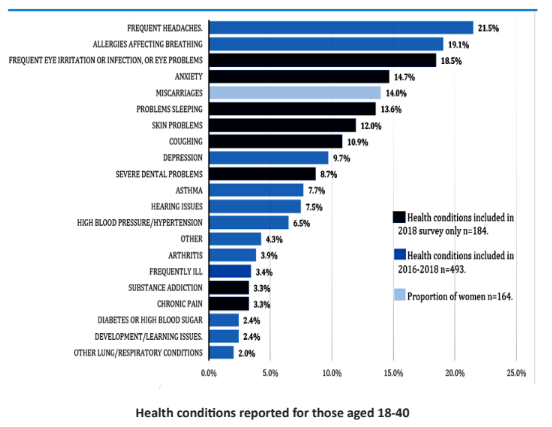
Health conditions reported for those aged 41 to 64
Frequent Health Issues
The most commonly reported health problem was high blood pressure or hypertension (36.2%). Roughly 1 in 4 reported allergies affecting breathing (25.4%), problems sleeping (25.2%) arthritis (24%), frequent headaches (23.3%) and frequent eye irritation or infections or eye problems (23.2%). About 1 in 5 reported diabetes (18.7%), depression (18.5%), with 13.2% reporting anxiety and 13.9% reporting asthma. Additional health problems were reported by 12% or fewer in this age group. Among women in this age group, 13.5% were reported to have experienced a miscarriage.

Health conditions reported for those aged 65 and older
Frequent Health Issues
Among those aged 65 and over, the most frequently reported health issues were arthritis (59.1%) and high blood pressure or hypertension (59.1%). Two in five reported frequent eye irritation or infection (44.4%), followed by problems sleeping (38.9%) and anxiety (36.1%). About a third reported allergies affecting breathing (32.2%), 30.6% reported coughing, 18.3%
reported other lung or respiratory conditions and 17.4% reported asthma. Roughly one in three reported chronic pain (30.6%), followed by diabetes (28.7%), depression (28.7%), heart disease or COPD (26.1%) or severe dental problems (25.0%). About one in five reported hearing issues (22.6%), skin problems (22.2%), or frequent headaches (18.3%). About 16% of
women in this age group reported having experienced a miscarriage. Other health problems were reported by 15% or fewer in this age group.
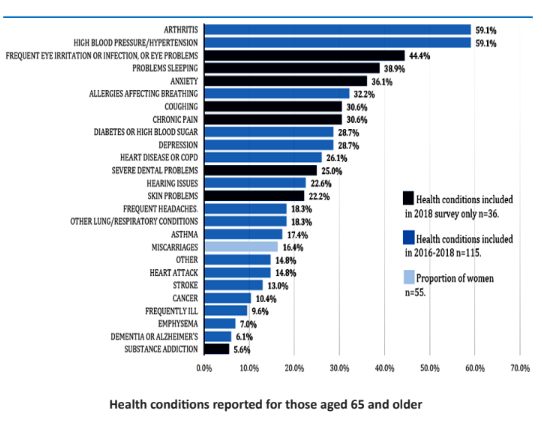

Recommendations To
Reduce Emissions
Reducing pollutant emissions will reduce adverse health effects.
Reduce Idling
Increase enforcement of anti-idling ordinance be enabling multi-agency enforcement
Develop app or add capacity to Improve Detroit app for reporting idling issues
Utilize Clean Fuels
Require & monitor use of clean fuels throughout the GHIB area during construction process
Develop incentive programming to encourage use of zero-emission vehicles, including cars, trucks, and construction equipment
Increase Compliance With Air Quality Standards
Enact stronger emission standards for diesel engines
Enact more stringent air quality standards near highways
Expand Retrofitting
Expand diesel retrofits and fleet engine replacements
“Mandatory emission standards on semi-trucks to keep it [emissions] to a minimum, but affordable for truck owners to improve emissions”
“Pongan cosas en los camiones para reducir la contaminación(Retrofit the trucks to reduce contamination)”
-Survey participants

Recommendations To
Reduce Exposures
Health benefits can be attained by minimizing the exposures of workers
and residents to air pollutants once they are emitted.
Move Truck Routes
Establish and enforce trucking routes that have the least impact on residential neighborhoods & areas with sensitive populations
Require Spatial Buffers
Require spatial buffers of at least 500 feet between heavily trafficked roadways and land uses with sensitive populations
Expand relocation opportunities to a minimum of 500 feet & increase uptake Home Sway Program among eligible families
Install Vegetative Buffers
Plant vegetative buffers in strategic places near the GHIB, prioritizing residential areas with sensitive populations, freeways, heavily trafficked roadways, areas with high cumulative risk & areas where minimum setbacks are not met
Plant trees throughout Southwest to replace those removed during initial construction phase of GHIB
Extend Filter Programming
Extend programming for high efficiency filters and other retrofits in homes near construction yards and site for the Gordie Howe Bridge, up to 500 feet from roadways
“Different routes for trucks, time limits for when trucks go down side streets”
“More trees, buffers, parks for the environment”
“Provide air filters for the interior of the home because my daughter has asthma”
-Survey participants
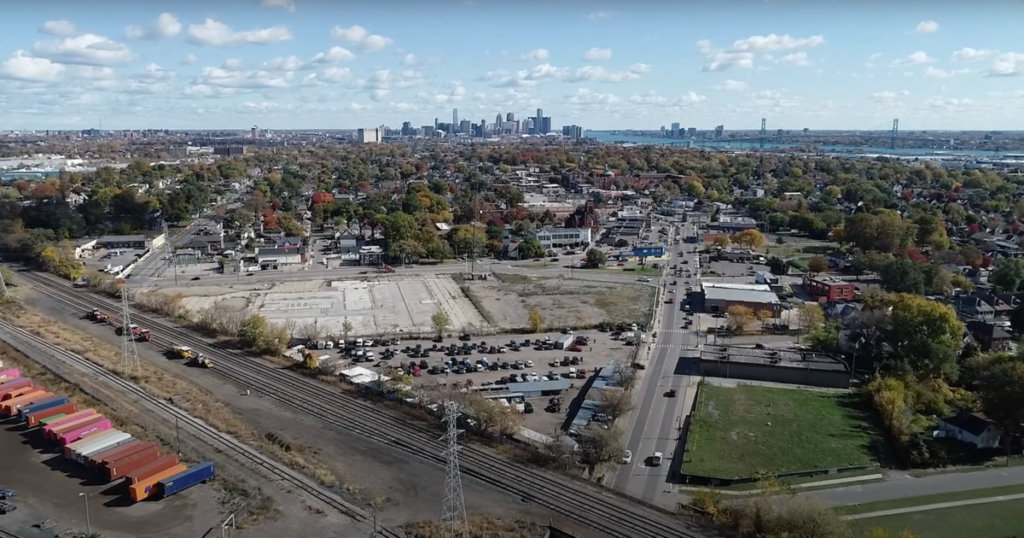
Other Relevant Strategies
Several additional strategies could impact resident’s quality of life and the ability to understand the impacts of air quality on resident’s quality of life.
Expand Health Care Access
Expand access to health care by assuring access to health insurance, neighborhood-based mental health and physical health care sources, and addressing transportation issues
Support Monitoring
Support expanded monitoring of air quality
“Look into safety and health, think about the people that have been here for years”
“Take in consideration the health of the community – the children, and moms to be, and adults”
-Survey participants
Check back for future health reports conducted during the Gordie Howe bridge construction and after operation
